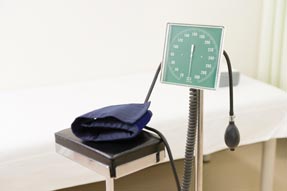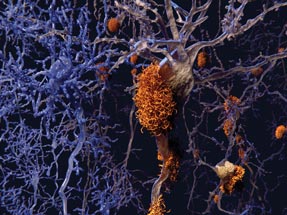Integrative therapies may complement care
A growing base of evidence suggests that certain treatments may have a place in physicians' repertoires as part of a holistic approach to health.
For millennia, healers have utilized ancient therapies, such as acupuncture and meditation, to bolster wellness and treat diseases of the mind and body. But in the 20th century, nonconventional treatments had been largely separate from conventional practice in the U.S. That may be slowly changing.
About 1 in 3 U.S. adults used unconventional care in 1990, according to a 1993 study published in The New England Journal of Medicine. Patients continue to experiment with nonconventional treatments, with about one-third of U.S. adults reporting past-year use of any complementary health approach in the 2012 National Health Interview Survey. And many physicians acknowledge that certain nonconventional practices may have a role in treating today's most debilitating and costly diseases, such as chronic pain.

In 2015, Congress changed the name of the relevant NIH research hub from the National Center for Complementary and Alternative Medicine (NCCAM) to the National Center for Complementary and Integrative Health (NCCIH). The new term, “integrative,” describes the use of evidence-based nonconventional healing practices as an adjunct to conventional medicine.
“Integrative medicine, for me, provides me additional options to offer to my patients when conventional medicine is limited,” said Sanford Levy, MD, FACP, an integrative medicine physician who practices in Buffalo, N.Y. “I distinguish integrative medicine, which I think of as being the tools in my tool chest, from holistic medicine, which I consider to be more of a philosophy. Holistic medicine offers me a framework, which all medicine really should focus on, which is ... striving to evaluate each patient in the context of mind, body, spirit, community, and environment.”
Internists may be unsure about whether and how to include integrative medicine in their practices, not to mention their potential concerns about both the quality and quantity of research studies on nonconventional approaches. But with ongoing study by institutions such as NCCIH and Cochrane, a growing base of evidence suggests that certain treatments may have a place in physicians' repertoires as part of a holistic approach to health.
A new approach
ACP Member Bradly Jacobs, MD, MPH, an integrative medicine physician based in San Francisco, noted that integrative medicine can be practiced only by physicians and by naturopaths who are state-licensed to practice medicine. “Integrative medicine is defined as the blending or thoughtful incorporation of a range of different therapeutic disciplines, including conventional medicine,” he said. “So a chiropractor or an acupuncturist can't be an integrative medicine practitioner because they're not trained in conventional medicine.”
An example of an integrative medicine practice is the Mount Sinai Beth Israel Center for Health and Healing in New York, which employs primary care physicians and subspecialists, as well as nutritionists and acupuncturists. The center combines conventional modalities, such as medications, with complementary techniques, such as stress management, mind-body therapies, physical activity, and nutritional and herbal supplementation, said family doctor and research director Benjamin Kligler, MD, MPH.
“That's probably the philosophy in a nutshell: It's a combination of the fact that we use different kinds of modalities and approaches and that we try to really focus on helping the patient mobilize their intrinsic healing capacity,” he said.
Internist Martin H. Ehrlich MD, MPH, medical director at the center, added that many of the fundamental concepts of integrative medicine were not included or emphasized in his medical school and residency training. “We weren't taught about the healing capacity of the body, the importance of nutrition, exercise, stress management, the mind-body connection, mindfulness, and motivational interviewing to empower and motivate the patient,” he said.
Dr. Ehrlich took a midcareer sabbatical to train in nonconventional modalities, such as acupuncture, mindfulness-based stress reduction, medical hypnosis, and energy medicine, and includes them in his practice. He noted that many physicians have received such training through integrative medicine programs and that the Academic Consortium for Integrative Medicine & Health, a membership group of academic medical centers and affiliated institutions founded in 1999, has helped to incorporate integrative medicine into medical school and residency training.
“The most important thing I do is listen, to learn about the patient's issues and concerns, strengths and weaknesses, and to establish a rapport,” he said. “Making eye contact, using healing touch, and carefully choosing words can galvanize the healing process.”
But taking a holistic approach to medicine is limited by time constraints and a reimbursement system that doesn't pay adequately for spending time with patients, said Dr. Levy, who does not take insurance in his part-time practice. “Internists in general want to do that, but most feel they don't have the time to do it,” he said. However, those who are interested can work to incorporate a holistic approach into their practice without formal training by accessing reputable websites (see sidebar) and reading research on complementary medicine in the conventional medicine literature, Dr. Levy said. “The number of articles is relatively few, but they're not that infrequent,” he said.
Another challenge of integrative therapies is that they often require patient effort, Dr. Kligler noted. “A lot of these therapies that have good evidence nevertheless really do require a lot of work and motivation from the patient to be effective,” he said. “You have to be willing to spend the time or at least believe in the capacity of the patient to make the changes, and that's why ... it really helps to have a team. It helps to have a nutritionist on the team. There are also a lot of practices that are now using health coaches to help with promoting behavior change.”
A growing evidence base
New evidence in integrative medicine may nudge internists toward adopting more holistic treatment protocols, especially for difficult-to-treat issues like chronic pain. Chronic pain afflicts an estimated 100 million Americans, and the medical costs and loss of productivity total hundreds of billions of dollars each year, according to the National Academy of Medicine. In terms of indications for complementary approaches, chronic pain is 1 of the largest areas of research in academic medical centers across the country, said Josephine Briggs, MD, a nephrologist and director of the NCCIH.
“We know from national surveys that one of the main reasons people turn to complementary health approaches is for help with pain management,” she said. “We are seeing a growing evidence base that these nonpharmacological approaches to pain management, although they don't fully take the place of drugs for some people, are really helpful in getting people to feel more in charge of their pain, more self-management.”
Yoga, for example, appears to reduce short- and long-term chronic low back pain and back-specific disability compared to education, usual care, or exercise, according to a 2013 meta-analysis published in The Clinical Journal of Pain. Another study on chronic pain, published in 2015 by Pain Medicine, found that patients enrolled in a mindfulness-based stress reduction program reported better pain management than controls on a waiting list.
Although the underlying mechanisms behind this treatment effect are not fully understood, a 2014 study published in Cerebral Cortex found neuroanatomical enhancements of the insula to be related to yogis' higher pain tolerance. After the experienced yogis tolerated the pain of immersing their hands in cold water more than twice as long as matched controls, interviews showed that they had used strategies that focused on relaxation and acceptance, whereas most of the controls either tried to distract themselves or ignore the pain.
In 2015, The Joint Commission enacted a clarification of its pain management standard, recommending that clinicians offer both nonpharmacological options (including physical modalities such as acupuncture or massage therapy and cognitive behavioral therapy) and pharmacological options. “Strategies should reflect a [patient]-centered approach and consider the patient's current presentation, the health care providers' clinical judgment, and the risks and benefits associated with the strategies,” The Joint Commission said.
“I would say that pain management is one of the crucial areas that internists need to know about, particularly with the recent changes in how we're looking at using opioids for chronic pain because we've learned so much about the harms that we cause by overprescribing opioids. ... I think patients in general, and also physicians, are really hungry for effective alternatives to treating chronic pain, and I think we have some really good ones,” said Dr. Kligler, who also serves as vice chair of the Mount Sinai Beth Israel Department of Integrative Medicine.
Acupuncture, for instance, has been shown to be superior to sham procedures or no acupuncture for 4 chronic pain conditions: back and neck pain, osteoarthritis, chronic headache, and shoulder pain, according to a 2012 meta-analysis published in Archives of Internal Medicine. Chiropractic, massage, and yoga therapies also have reasonable evidence behind them, mostly for back pain, Dr. Kligler noted. Also, exercise in the form of resistance training, aerobics, and yoga has been shown to be helpful for back pain, and tai chi may be effective for fall prevention and pain relief for some conditions, according to Brian Berman, MD, founder and director of the University of Maryland Center for Integrative Medicine in Baltimore.
“To me, everything is an interplay between genomics, lifestyle behaviors, and environment. ... When it comes to something like chronic pain, it's multifactorial, usually, and it's not just one magic bullet that's going to have all the answers for that,” said Dr. Berman, who is also a professor of family and community medicine at the University of Maryland School of Medicine.
Dr. Berman pointed out that there are certain limitations to the available research on nontraditional therapies, such as small sample sizes and a lack of postsurveillance safety data. Studies on acupuncture, though, have shown it to be quite safe overall compared to pharmacological therapies, and mind-body therapies are rather safe in general, he said.
Looking at lifestyle
Much of the philosophy of integrative medicine is rooted in healthy living. When treating primary care patients, Dr. Jacobs said he first addresses lifestyle behaviors, teaching and enabling people to engage in self-care strategies. “I'm a big proponent of doing the things that are least invasive, least costly, and may have the greatest impact, and then moving up the scale from that to other therapeutic interventions that might be more invasive and have equal or more impact but have more risks to them,” he said.
Traditional markers of a healthy lifestyle include exercise, good nutrition, nonsmoking status, and a healthy body mass index. Dr. Jacobs uses what he calls “6 Pillars of Healthy Living” to highlight other components of a healthy lifestyle, such as restorative sleep, mental focus, balanced relationships, and finding meaning and purpose.
“I have a self-assessment that people fill out on those 6 pillars; then we spend a fair amount of time looking at those,” he said. “Then, we focus on one as the initial push toward improving people's quality of life, and what I've found is that when they focus on one, the other ones start to improve, as well.”
However, Dr. Jacobs noted, most internists are not trained in behavior change or lifestyle medicine and might be more comfortable prescribing a medication first. “Even if they do spend time recommending that people exercise, they aren't trained on how to pursue those recommendations and inform people and motivate them to actually engage in successful behavior change,” he said.
It takes considerable motivation for patients to commit to regular exercise, better eating habits, or weekly acupuncture sessions. To help effect behavior change, physicians can tap into patients' motivation by determining what they find important, either in the moment or in the future, Dr. Jacobs said.
“What I'll do is try and identify things that affect their quality of life on a day-to-day basis and focus on that as their motivation,” he said. For example, regular exercise might help patients feel stronger or improve their cognitive performance, he noted.
Dr. Berman said physicians can communicate better with patients if they understand such approaches as mind-body techniques and good nutrition and can start a dialogue.
“What we do know is that people are turning toward complementary and alternative therapies, whether they're mentioning it or not, and so it's good to have open communication about what is going on with our patients,” he said. Dr. Berman recommends suggesting good-quality, credible sources of information that patients can access, such as the NCCIH database.
Dr. Briggs added, “We do know that, by and large, a lot of these practices are paid for by people out of pocket. In some settings, these approaches are covered by insurers ... but to be willing to suggest and urge a practice—even if you can't write a prescription—is an important message.”
Continuous change
Dr. Berman said the field of integrative medicine has seen enormous change over the past couple of decades. “When I was first involved with it, it was almost something that you did off on the side and didn't mention,” he said. “There's a sea change in the attitude of the medical profession, as well as even payers covering more acupuncture and some of the therapies.”
Dr. Kligler predicted even greater changes to come. “A lot of us feel that someday, integrative medicine maybe should vanish as an idea because we will have helped inform the whole discussion around medicine so that the barriers to incorporating things that are outside the standard paradigm have gotten lower,” he said, “and [physicians] will just look at what has good evidence and what's safe and what patients feel comfortable trying, and that's how they'll make decisions.”
Future research will provide more insight on which therapies work and for whom through comparative effectiveness trials and studies on different populations, and additional research on expensive chronic diseases has the potential to lower costs, Dr. Berman said. Current research studies funded by the Patient-Centered Outcomes Research Institute are comparing individual versus group acupuncture for chronic pain in ethnically diverse, medically underserved populations, as well as comparing acupuncture and cognitive behavioral therapy in treating insomnia and other symptoms in cancer survivors, he said.
“I think we'll see more and more that [medicine is] putting the patient in the center and then seeing what's best for that person, whether it's a diet, whether it's a drug and diet, or it's exercise, or it's stress management,” Dr. Berman said. “It boils down to good, whole-person care: making available the best treatment for that individual person.”





